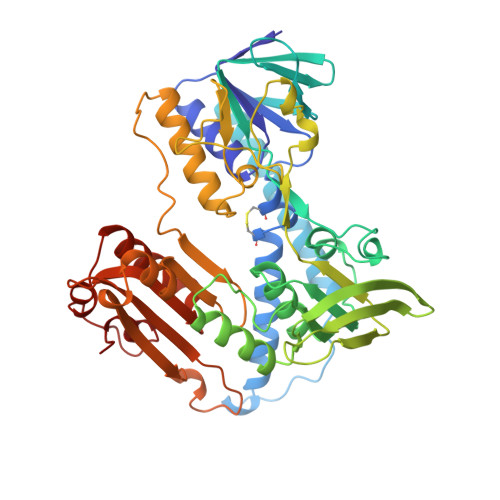Kinetics and crystallographic analysis of human glutathione reductase in complex with a xanthene inhibitor.
Savvides, S.N., Karplus, P.A.(1996) J Biological Chem 271: 8101-8107
- PubMed: 8626496
- DOI: https://doi.org/10.1074/jbc.271.14.8101
- Primary Citation of Related Structures:
1XAN - PubMed Abstract:
We have determined the crystal structure of a complex between the noncompetitive inhibitor (Kis = 27 microM, Kii = 48 microM with respect to oxidized glutathione (GSSG) and Kis = 144 microM, Kii = 176 microM with respect to NADPH) 6-hydroxy-3-oxo-3H-xanthene-9-propionic acid (XAN) and human glutathione reductase (hGR). The structure, refined to an R-factor of 0.158 at 2.0 A resolution, reveals XAN bound in the large cavity present at the hGR dimer interface where it does not overlap the glutathione binding site. The inhibitor binding causes extensive local structural changes that primarily involve amino acid residues from a 30-residue alpha-helix that lines the cavity and contributes to the active site of hGR. Despite the lack of physical overlap of XAN with the GSSG binding site, no GSSG binding is seen in soaks carried out with high XAN and GSSG concentrations, suggesting that some subtle interaction between the sites exists. An earlier crystallographic analysis on the complex between hGR and 3,7-diamino-2,8-dimethyl-5-phenyl-phenazinium chloride (safranin) showed that safranin bound at this same site. We have found that safranin also inhibits hGR in a noncompetitive fashion, but it binds about 16 times less tightly (Kis = 453 microM, Kii = 586 microM with respect to GSSG) than XAN and does not preclude the binding of GSSG in the crystal. Although in structure-based drug design competitive inhibitors are usually targetted, XAN's binding to a well defined site that is unique to glutathione reductase suggests that noncompetitive inhibitors could also serve as lead compounds for structure-based drug design, in particular as components of chimeric inhibitors.
- Section of Biochemistry, Molecular and Cell Biology, Cornell University, Ithaca, New York 14853, USA.
Organizational Affiliation:


















